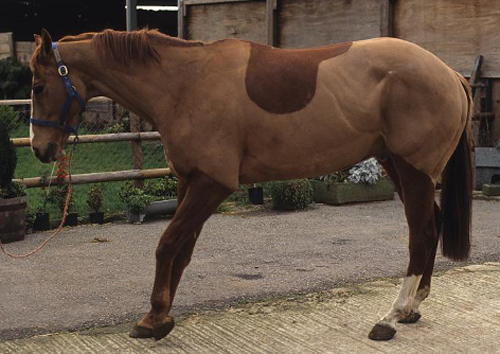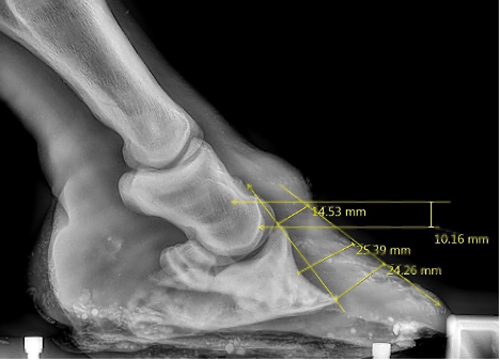Laminitis, or “Founder” as it is often known as, is unfortunately a condition that is seen too commonly in horses, occurring in any horse regardless of breed, use, or activity. Having said this, mature horses and ponies are often over-represented.
What is Laminitis?
Simply put, laminitis is an inflammation of the laminae, the sensitive tissues that connect the hoof wall to the pedal bone and other structures in the foot. The laminae play a major role in stabilizing the bones inside the foot. When inflammation occurs, the integrity of this crucial bond is often compromised, leading to serious damage to the bones and soft tissue. In severe cases, rotation or sinking of the pedal bone may occur resulting in extreme damage to the internal structures of the hoof. It is at this point that laminitis may become a life-threatening condition.
What causes laminitis?
Laminitis is a confronting disease, and the definitive causes in many cases remain unknown.
What is known however, is that excessive consumption of highly metabolisable carbohydrates, such as those found in grain or lush grass, is most commonly implicated in cases of laminitis.
Some other causes exist and are known, and these include;
- Disease associated with sepsis (blood poisoning)
- Endotoxaemia (which can be caused by grain overload)
- Excessive weight placed on a limb due to injury to the opposite limb.
- Cushing’s disease in older horses
- Equine metabolic Syndrome (EMS) including pasture associated laminitis (most commonly observed in spring).
Regardless of the inciting cause, venoconstriction (narrowing of blood vessels) and coagulopathies (blood clotting) within the veins and arteries of the foot are thought to occur. This creates an environment of stressed tissue, with reduced blood supply and acute inflammation resulting in loss of adhesion of the laminae.
There is a range in severity and progression of disease between cases, and this is often due to the underlying cause. For example Equine Metabolic Syndrome is often implicated in pasture-associated cases of laminitis, and there is often a wide variety in the severity of cases for unknown reasons. This is opposed to grain overload induced laminitis which will most commonly result in severe laminitis which may progress rapidly.
What are the signs?
Lameness is most commonly observed in both front feet, but all four feet, or only a single foot, can be affected also. Other signs include;
- Increased temperature of one or more hooves
- Increased digital pulses,
- Painful withdrawal response to hoof testers over the toe.
The characteristic stance of a laminitic horse with both front feet affected is placement of the fore feet in front of the normal position and forward placement of the hind feet in order to shift more weight to the hindlimbs.


How is laminitis diagnosed, and how do I know how bad it is?
Diagnosis of the disease is made by the veterinarian based on history, the stance of the horse, and examination of the affected limbs. Nerve blocks may be used to confirm the source of the pain.
The severity can be established by examining the hoof wall, sole, and coronet band, and by performing radiographs which allow for measurement of the movement/rotation of the pedal bone. In chronic cases, multiple radiographs are often required to establish if further rotation or movement of the pedal bone has occurred.
How do I treat laminitis?
Treatment is centred around reducing the inflammatory reaction and to stabilise the degree of displacement within the foot. Concurrent treatment of the inciting cause (if known) is also important.
In acute cases;
- Use of Non-Steroidal Anti-Inflammatories (NSAIDs), such as Phenylbutazone is considered the main treatment in acute cases of laminitis.
- Cold therapy, with cold water, or ice boots may also be useful in early cases to reduce the heat and inflammation within the foot.
- Attempts should also be made to redistribute the force of weight-bearing away from the hoof wall. These may include removal of shoes, placing affected horses in sand, or shavings, of placing soft foam pads on their soles.
In terms of chronic cases of laminitis, or patients recovering from laminitis, corrective trimming/shoeing is extremely important and may require ongoing assessment by both your veterinarian and farrier to ensure excessive load is not placed on the affected laminae and to work towards restoring the stability of the laminae and underlying pedal bone within the hoof.
Southwest equine is currently offering a special price for hoof/pedal bone x-rays to help assist you with management of laminitis in your horse. If you need further information, just give our team a call.
DIGITAL RADIOLOGY – PEDAL BONE / LAMINITIS
Laminitis (founder) is a common problem for our equine companions.
Thankfully there is a simple way to firstly: assess if your horse has or has had laminitis, and secondly, measure the severity!
Digital radiology is a simple tool that can be used to assess if your horse has laminitis, or has any degree of pedal bone rotation.
Cost $150 per horse.
Cost includes the consult fee, hoof x-rays (4 views), copies of the x-rays and a full report.


